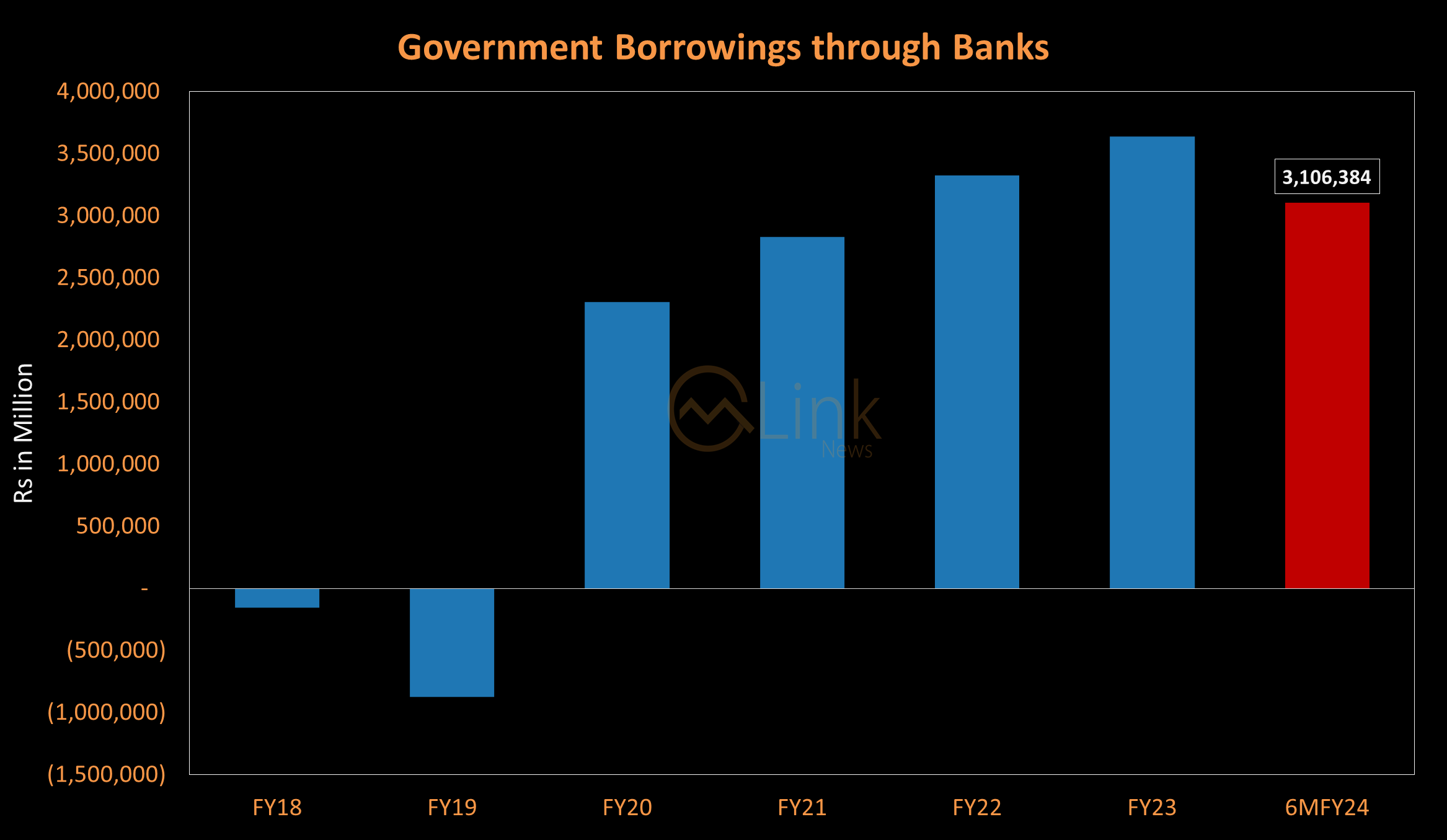Govt's elevated bank borrowings cast shadows over Pakistan's economic outlook

By Rafay Malik | January 08, 2024 at 05:47 PM GMT+05:00
January 08, 2024 (MLN): Government borrowings from banks are following a troubling upward trend, pushing the country deeper into the debt tunnel and casting shadows over its poised positive economic outlook.
The latest data for the six months till December 2023 (6MFY24) showed that borrowing through banks spiked to Rs3.214 trillion as opposed to Rs1.019tr recorded during the corresponding period last year.
This reflects a massive surge of 3.15x and shows that borrowing through this mode is surging to extremely alarming levels.
It is crucial to note that the country is under the reign of a caretaker setup, and these figures indicate that within six months, the government has already accumulated a level of debt as it did for the entire fiscal year 2023.
.png)
The government borrows money from banks to bridge the gap between its revenues and expenses, refinance existing debt, rebuild reserves, finance public sector projects, and for several other purposes. At the same time, banks are most willing to lend to governments because they are considered the safest and most secure lending option.
However, what comes as a shock is that despite the resilient performance demonstrated by the Federal Board of Revenue (FBR) in tax collections, the government has heavily turned to banks for additional funds.
As per the latest figures, the revenue board has made history by collecting over Rs1 trillion in the month of December for the first time.
Moreover, FBR’s collection for 6MFY24 stood at Rs4.468tr, surpassing significantly the set target of Rs4.425tr for the review period.
Economic concerns widen as these borrowing figures contradict the government's goal of optimizing the allocation and expenditure of public funds.
The caretaker government only authorized the utilization of development funds amounting to Rs300.904 billion, out of a total allocation of Rs950bn for various ongoing and new social sector uplift projects of the federal ministries and divisions during the first four months of FY24.
While on the other hand, these high borrowing figures indicate the possibility of a rising Public Sector Development Programme (PSDP).

Potential impacts of high bank borrowings
Pakistan’s economy is showing certain signs of recovery in the form of rising reserves, a bullish equity market, almost a successful second loan tranche with the International Monetary Fund (IMF), a strengthening domestic currency, and a positive current account balance.
However, it is a bitter reality that the inflows of foreign currency from multilateral and bilateral partners come in the form of loans, which must be repaid, incurring significant financial costs.
In this case, the economy is already running under the burden of high principal and debt repayment, and with increased bank borrowings, the government is blocking its path towards a sustained economy.
In order to meet these debt payments associated with high borrowings, the government may have to transfer this burden to the general public through increased taxes.
Elevated taxes would increase prices, creating a burden for domestic consumers and simultaneously weakening the competitiveness of domestic goods in international markets.
Thereby, the outlook for the overall fiscal health of the economy appears in the dark with the potential consequences of substantial borrowings expected to have a significant impact in the near future.
Copyright Mettis Link News
Related News
| Name | Price/Vol | %Chg/NChg |
|---|---|---|
| KSE100 | 125,627.31 258.99M |
1.00% 1248.25 |
| ALLSHR | 78,584.71 1,142.41M |
1.16% 904.89 |
| KSE30 | 38,153.79 69.25M |
0.63% 238.06 |
| KMI30 | 184,886.50 91.38M |
0.01% 13.72 |
| KMIALLSHR | 53,763.81 554.57M |
0.54% 290.61 |
| BKTi | 31,921.68 33.15M |
1.78% 557.94 |
| OGTi | 27,773.98 9.65M |
-0.40% -112.21 |
| Symbol | Bid/Ask | High/Low |
|---|
| Name | Last | High/Low | Chg/%Chg |
|---|---|---|---|
| BITCOIN FUTURES | 107,650.00 | 107,860.00 107,555.00 |
-585.00 -0.54% |
| BRENT CRUDE | 66.63 | 67.20 65.92 |
-0.17 -0.25% |
| RICHARDS BAY COAL MONTHLY | 97.00 | 97.00 97.00 |
1.05 1.09% |
| ROTTERDAM COAL MONTHLY | 107.65 | 107.65 105.85 |
1.25 1.17% |
| USD RBD PALM OLEIN | 998.50 | 998.50 998.50 |
0.00 0.00% |
| CRUDE OIL - WTI | 64.96 | 65.02 64.83 |
-0.15 -0.23% |
| SUGAR #11 WORLD | 16.19 | 16.74 16.14 |
-0.52 -3.11% |
Chart of the Day
Latest News
Top 5 things to watch in this week
Pakistan Stock Movers
| Name | Last | Chg/%Chg |
|---|
| Name | Last | Chg/%Chg |
|---|



